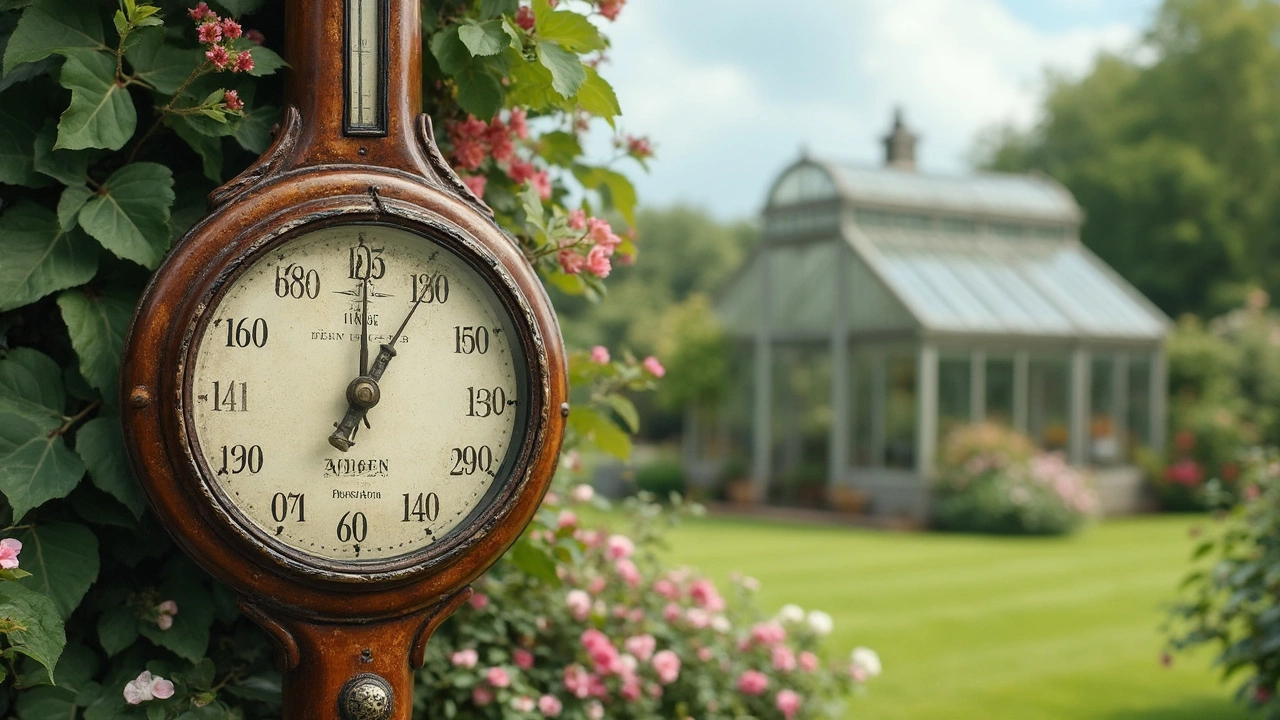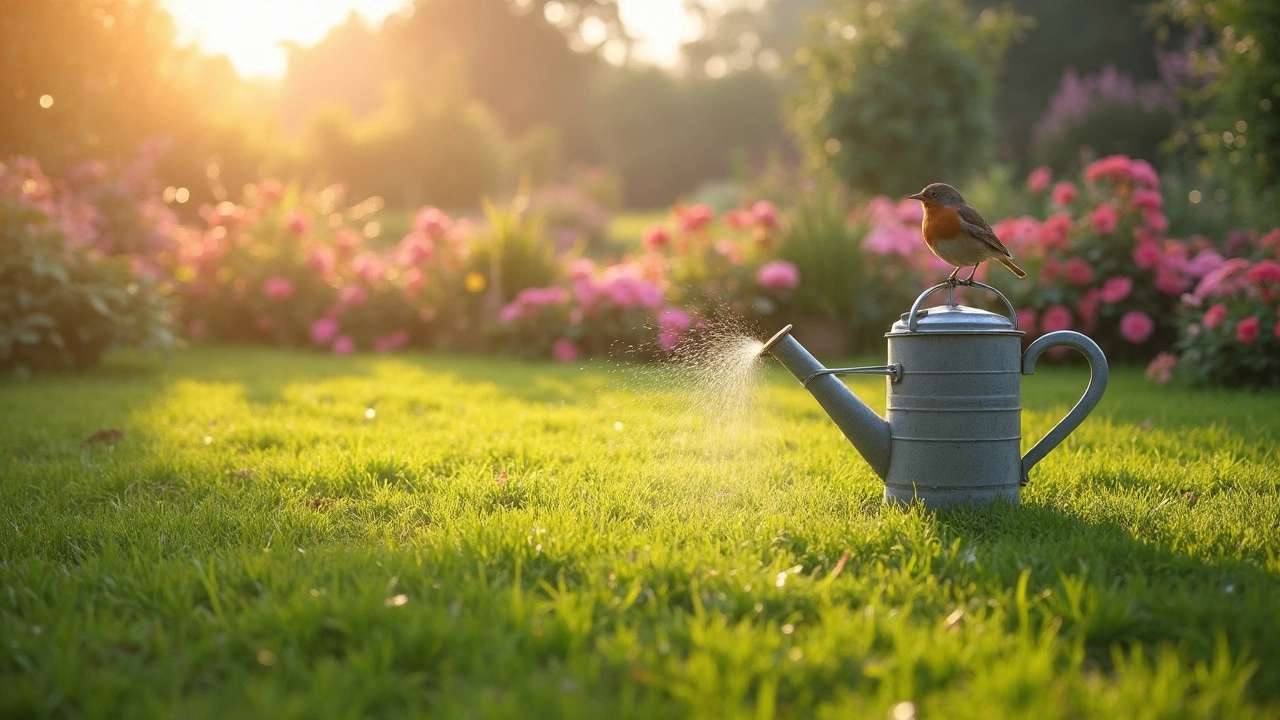Maintaining a good lawn isn't just about mowing regularly or tossing down random fertilizers. It's all about understanding your lawn's thirst. Let's talk about watering—yep, it's the single most critical factor in keeping your grass looking lush.
Proper watering keeps your lawn healthy and hydrated, but it's not as simple as it sounds. You might be asking, 'When should I water?' or 'How much is too much?' Timing and technique matter just as much as the water itself.
Water your lawn early in the morning to minimize evaporation and let the soil soak up the goodness before the sun heats up. Aim for infrequent but deep watering to encourage roots to grow deeper, making your grass more drought-resistant.
- The Role of Watering
- Timing is Everything
- Techniques for Effective Watering
- Signs of Over and Under Watering
- Seasonal Watering Adjustments
- Environmental and Economic Benefits
The Role of Watering
Watering is the cornerstone of any effective lawn care routine. It's like giving your lawn a life-saving drink, and doing it right can mean the difference between a thriving green space and a sad dry patch. You might be surprised, but watering isn't just about turning on the hose. It's a bit of an art and a science.
Proper watering techniques boost your lawn’s health by encouraging deeper root growth, which in turn makes it more drought-resistant. This means less fussing over the grass and more time enjoying it. Plus, when you master watering, you reduce the risks of fungus and pests that thrive in overly damp environments.
So, what makes a good watering routine?
Watering Frequency and Amount
Most lawns need about 1 to 1.5 inches of water per week, depending on your local climate and the specific grass type you're dealing with. The trick is to water deeply but infrequently, perhaps once or twice a week. This encourages the roots to stretch downwards in search of moisture, making them sturdier.
Smart Watering Tips
- Avoid watering in the evening, as the dampness can invite mold and pests. Morning is prime time since the sun helps to dry the grass naturally.
- Use a rain gauge or even an empty tuna can to measure the water your sprinkler delivers. It’s a simple hack that can save you from over or under-watering.
- Consider using soaker hoses or drip irrigation systems for more targeted watering, reducing evaporation and runoff.
Got all that? Great! Here’s a quick reference:
| Time of Day | Action |
|---|---|
| Early Morning | Water the lawn |
| Midday | Avoid watering |
| Evening | Avoid watering |
Doing this consistently will transform your grass maintenance routine, ensuring your lawn stays lush and vibrant. Remember, it's not just water but how and when you deliver it that counts.
Timing is Everything
When you're thinking about your lawn's needs, remember that timing truly is everything. Getting your watering schedule right is crucial for your grass to thrive.
Early Morning Magic
The early bird catches the worm, and in this case, it keeps the lawn healthy! Watering in the early morning, between 6 AM and 10 AM, is ideal. The cooler temperatures and gentle morning sun allow the water to seep into the soil efficiently, reducing evaporation. This means more moisture reaches the roots, which is essential for a healthy lawn.
Skipping Afternoon Heat
Watering your lawn in the afternoon isn't a great idea. The sun is at its fullest then, causing much of the water to evaporate before it even finds its way to the roots. Plus, using a sprinkler at this time can lead to 'sunburned' leaves, as water droplets act like tiny magnifying glasses on your lawn.
Evening Water Woes
It might seem tempting to water the lawn in the evening to save time, but this can cause problems too. While soil may stay moist longer, the grass remains wet overnight, making it susceptible to disease. Fungal growth is particularly fond of these conditions, which isn't what you want for a healthy lawn.
Weekly Schedule
| Day | Watering Time |
|---|---|
| Monday | 6 AM - 9 AM |
| Thursday | 6 AM - 9 AM |
For most regions, watering twice a week is sufficient. Adjust based on weather—rainy weeks need less, dry spells might need a little more. Overwatering can be as bad as underwatering, so find that sweet spot for your lawn's sake!
Techniques for Effective Watering
Getting watering right is crucial for a healthy lawn. It’s not just about turning on the hose and letting it run. There are some nifty techniques to make sure your lawn gets exactly what it needs without wasting water.
Know Your Soil Type
First off, identify your soil type. Clay holds water longer, so it needs less frequent watering, whereas sandy soil drains quickly and might need more.
Watering Depth and Frequency
For deep root growth, water deeply. This means soaking the soil down to about 6 inches. Generally, aim for about 1 to 1.5 inches of water per week. One way to check is by placing a small container on your lawn when you water and measuring the depth.
Tools of the Trade
Consider investing in a good sprinkler system. Oscillating sprinklers work well for square lawns, while rotary ones are better for larger areas. A smart controller can adjust your system based on weather forecasts, ensuring you don’t end up watering in the rain.
Optimize Sprinkler Use
- Position sprinklers to avoid watering sidewalks and driveways.
- Run sprinklers earlier in the morning when wind and sun evaporation are lower.
- Watch for runoff. If water starts to run off your lawn, stop watering, let it soak in, then resume.
Importance of Aeration
Aerate your lawn once a year to allow water to penetrate deeper into the soil. This improves water uptake and reduces puddling.

Signs of Over and Under Watering
Ever wonder if you're drowning your lawn or leaving it parched? Striking the right balance is crucial to keep your lawn care game on point. Let's dive into some easy signs to help you figure out if your lawn's water intake is just right.
Spotting Overwatering
If your grass starts to look more yellow than green, it might be a cry for help. Overwatering can wash away vital nutrients, leaving your lawn malnourished. Other hints? Mushy soil—step onto your lawn and it feels like a sponge, you're probably overdoing it. Weeds like crabgrass thrive in overly wet conditions, so if they're making a strong appearance, it's time to reconsider your watering habits.
Clues for Underwatering
On the flip side, if your lawn feels like prickly straw, it’s likely crying out for a drink. Look out for grass blades that are curling or browning at the tips. Another tell-tale sign? Footprints. Yep, if your footprints linger, your lawn is likely pleading for more H2O. A thirsty lawn can go dormant, which means it’s not dead, just asleep, waiting for water.
Finding the Right Balance
So, what's the magic trick? Observation. Check your lawn regularly. Stick a screwdriver into the soil; if it doesn't push in easily, it's a hint to water a bit more. Or, use a soil moisture meter for precise monitoring—it's like having a Fitbit, but for your grass! Here's a quick stat: lawns generally need about 1-1.5 inches of water per week.
Remember, perfecting your lawn maintenance is all about knowing these signs and adjusting accordingly. It'll save you time and give your lawn just what it asks for.
Seasonal Watering Adjustments
Adjusting your watering routine according to the season is key to maintaining a healthy lawn. Different times of the year bring changes in temperature and rainfall, and your lawn care habits need to reflect that.
Spring
Spring is the time when your grass starts waking up from its winter slumber. As the temperatures rise, your lawn will need more frequent watering. Aim for once a week, ensuring the soil is moist at least six inches deep. Spring showers can help, so keep an eye on forecasts to adjust accordingly. Remember, overwatering can lead to fungal growth.
Summer
The heat of summer can be tough on your lawn. It's crucial to maintain an effective watering schedule, targeting early morning to reduce evaporation loss. Watering deeply two to three times a week should suffice, but you might need more during extraordinarily hot spells. Warmer weather encourages quicker evaporation, so always check soil moisture.
| Season | Water Frequency |
|---|---|
| Spring | Weekly |
| Summer | 2-3 times a week |
| Autumn | Every 10-14 days |
| Winter | As necessary |
Autumn
As autumn rolls in, temperatures cool, and your lawn's growth slows. It's a good time to reduce watering to about every 10 to 14 days, giving grass a chance to prepare for winter dormancy. Watch out for heavy rains during this season; you may not need to water at all if Mother Nature takes care of it.
Winter
Winter watering depends heavily on your area's climate. In milder winters, an occasional watering every three to four weeks can be beneficial if it's particularly dry. However, if the ground is frozen or if you've had heavy rain, it's best to leave watering when nature does it for you.
These lawn tips can make a huge difference in the health of your grass throughout the year. Adapting your grass maintenance strategy seasonally ensures that your lawn stays vibrant and resilient, no matter what the weather throws its way.
Environmental and Economic Benefits
Let's face it, keeping a healthy lawn isn't just about aesthetics. There's an eco-friendly and cost-saving side to it that's worth knowing about. A well-maintained lawn offers several economic and environmental perks.
Environmental Upsides
Your lawn acts like a green sponge, absorbing carbon dioxide and releasing oxygen. Grass is a natural air filter, reducing dust and pollutants. Plus, a dense lawn can cool the environment, reducing the heat island effect in urban areas. Think of it as your personal air conditioner.
Lawns also help in rainwater management. Grass minimizes runoff, allowing water to percolate back into the ground, replenishing groundwater supplies. This helps prevent flooding and promotes healthier ecosystems.
Economic Benefits
Sure, lawn care seems like it could be a money pit, but in reality, a healthy lawn can boost your property value. Homes with well-kept lawns or landscapes sell quicker and at a higher price.
And don't underestimate the savings on cooling costs. A healthy, shaded lawn can naturally lower the temperature around your home, cutting down on air conditioning usage.
Quick Stats
| Benefit | Potential Impact |
|---|---|
| Air Quality Improvement | Absorbs up to 10% of air pollutants |
| Groundwater Recharge | Reduces runoff by 58% |
| Property Value Increase | Up to 15% more resale value |
So, the next time you're out there tending to your lawn, remember you're not just chasing green; you're investing in your home and the planet's health.
